Turquoise: description of the stone, its types and properties

Turquoise is a mineral that has fascinated with its color for centuries. The unusual properties of this semi-precious stone and the positive effect on the human body have been appreciated since ancient times. Nowadays, it is becoming more and more popular.
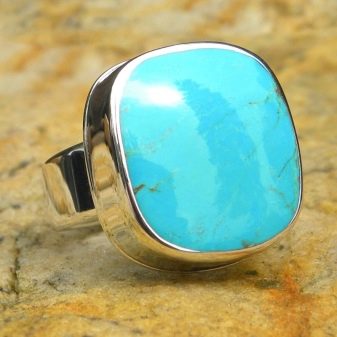
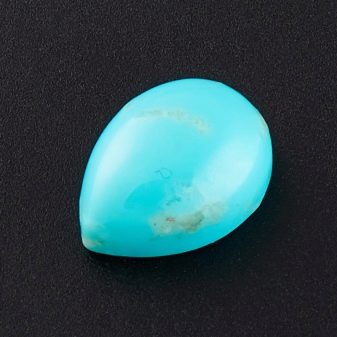
Description
This rare stone owes its popularity to the state located on the Mediterranean coast - Turkey. It was through this region that a trade route once led, along which turquoise was delivered from Persia to Europe. In Persian, this stone was called "pyruzeh" - "victory", although initially it appeared under the name "kalayt" (from the Greek "beautiful stone"). The first mention of him appeared in the writings of the Roman writer Pilinius the Elder.

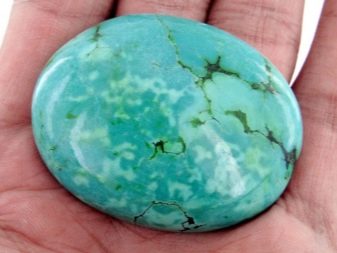
The origins of this stone date back to 3000 BC. NS. Then the places of extraction of turquoise were the Sinai Peninsula and Iran. This stone has always been attributed to extraordinary properties. Therefore, the soldiers attached great importance to the mineral and willingly chose it as a talisman. He was believed to be able to silence his anger and help reconcile even the most implacable enemies.
The ancient Aztecs and Mayans appreciated the noble colors of turquoise and willingly used it to create various decorations: masks, handles of sacrificial knives, mosaics and even to decorate human skulls. Scientists claim that it was in these places that there were many craft workshops specializing in the processing of the "stone of heaven". This elite symbol of dignity was also often used as a means of payment and was exchanged for valuable commodities such as exotic bird feathers or cocoa beans.
All this indicates its great value.
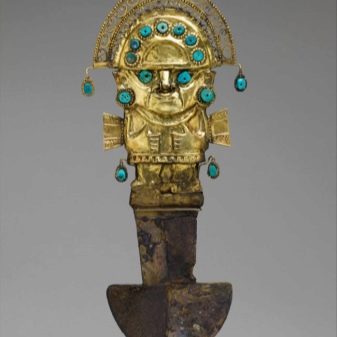

Turquoise was known in ancient China and Tibet, where it was believed that this stone brings prosperity and health, protects from evil forces. In addition, Tibetans considered turquoise to be a national symbol, especially appreciating its green hues (although usually blue is considered more valuable).
In ancient Egypt, this mineral was a valuable decorative stone from which various figurines and decorations were made, as evidenced by the finds in the tombs of Egyptian rulers: a death mask and the inside of Tutankhamun's tomb, lined with turquoise. For the ancient Egyptians, it was also an amulet - its blue color was considered a symbol of renewal, therefore special properties were attributed to the stone.
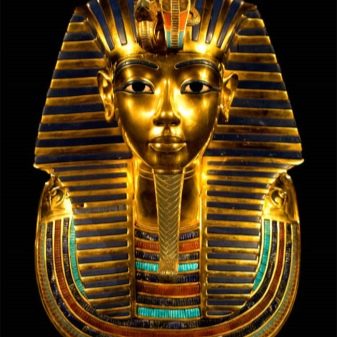
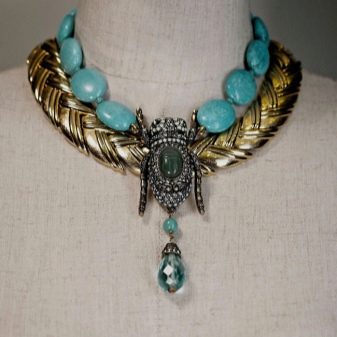
In the views of many civilizations, turquoise was a talisman that ensures happiness and longevity. It was also believed that the color of turquoise reflects the health of its owner. Bright and intense - when the wearer was in good health. And the stone had to turn pale and turn gray in case of illness of its owner. They believed that turquoise can speak, and even that it dies with the death of its owner.
Turquoise is a mineral belonging to the phosphate cluster. It is a compound of copper hydrate and aluminum phosphate. The presence of copper gives it blue tones, while iron gives the stone green tones. Turquoise can range in color from light blue, blue, green-blue to green. But it can also be white, gray and yellowish gray. The shade of turquoise can change with temperature.
The color change causes both heat and exposure to sunlight.

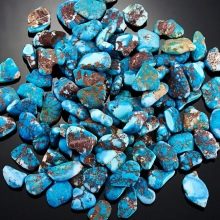

Since turquoise is an extremely soft stone, it has often been used as an inlay in the past. As a decorative stone - both before and today - these are mainly cabochons of various shapes used in rings, earrings, necklaces and bracelets. Turquoise is often found in smooth or faceted balls, ovals, and discs... It looks good in the company of not only gold, but also silver (especially oxidized) and goes well with red coral.
And turquoise drops and tears are perfect for earrings.

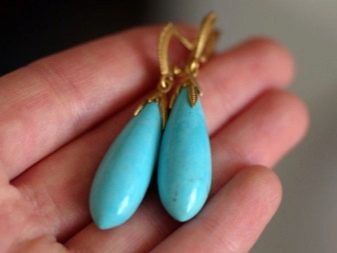
Where is it mined?
To this day, Iran remains an important source of turquoise mining, from where the beautiful blue material comes from. However, the main turquoise market is largely controlled by China and Tibet.
Different turquoise deposits yield different materials with a characteristic color and appearance. For example, the Sleeping Beauty mine is known for its light blue turquoise.
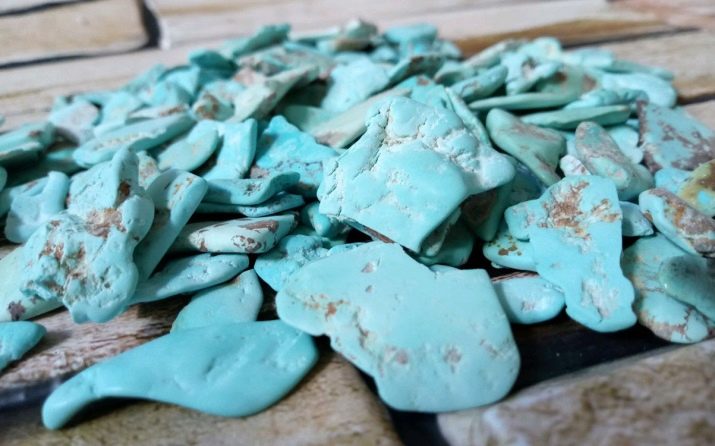
Most of the turquoise Kingman Mine is bright blue with black spider webs. The Morenci mine produces a lot of deep blue turquoise with a pyrite content. Most of the Bisbee turquoise is bright blue with a chocolate brown matrix. Turquoise savvy people can often associate the stone correctly with a particular mine.
Naturally, turquoise forms best in arid climates and this determines the geography of turquoise springs. Most of the world's turquoise raw materials are currently produced in the southwestern United States, China, Chile, Egypt, Iran, and Mexico. In these areas, sediment seeps through soil and rocks, wetting small amounts of copper. When this water later evaporates, the copper combines with aluminum and phosphorus.
... Thus, a small amount of turquoise appears, deposited on the walls of underground cracks.
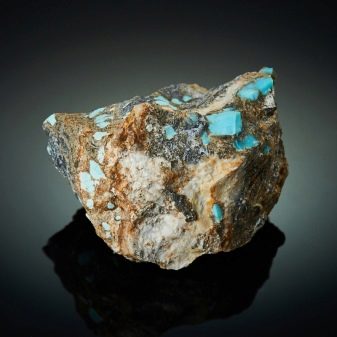

Turquoise can also replace rock. After this transformation, a solid mass of turquoise will form. If the replacement is incomplete, the remains of the rock in turquoise will look like a "matrix". The matrix can form a "web", "spotted" or other pattern inside the stone.
Most of the turquoise mined is usually a by-product of copper production... When turquoise is encountered in copper mining, the quantity and quality of the material is evaluated. If the value of turquoise is worth extracting, it will be mined.

Views
Let's consider several varieties of this beautiful stone.
Natural turquoise
Turquoise can have a uniform color, but there are also inclusions of other minerals in the form of lighter or darker spots or veins.
The most valuable rock comes from Iran (Nishapur region) - it has been mined there for two thousand years, and now this region is an important source of production. Another place for obtaining this mineral is the Sinai Peninsula, where the stone has been known since about 3000 BC. NS. The following types of turquoise are found on the market today:
- Chinese;
- Tibetan;
- Iranian;
- Arizona;
- Turkmen;
- Australian;
- brazilian;
- Kazakh;
- Uzbek;
- Russian;
- Armenian;
- Tajik;
- indian;
- Turkish;
- Chilean;
- Mexican;
- Peruvian;
- Ethiopian;
- African;
- Sudanese;
- Tanzanian;
- French;
- British.
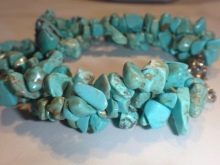
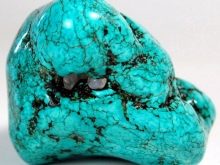
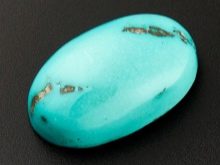
The best stones come from Australia, Iran, Afghanistan, Tibet, and the southwestern United States.
Good examples are also found in France, Great Britain, Russia, Poland, Arabia, Egypt, China, Peru and Mexico. The color of these stones is usually the classic one, which we call turquoise blue, but stones are also available in other colors. These are green stones from Tibet, white turquoise stones, pink ones, some rather unusual purple species and a beautiful light "Sleeping Beauty".
It is becoming more and more difficult to get all the colors of this stone in natural form. Blue turquoise is formed when copper is present. Green turquoise forms when iron is nearby. Although white turquoise is known to form when none of these metals are found in stone, white specimens are quite rare. Unless sometimes you can see white spots in blue or green stones.

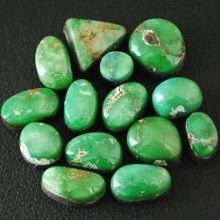
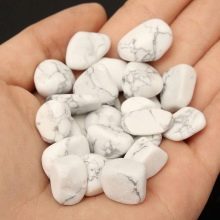
Turquoise cabochons
Today there is a huge, varied line of turquoise cabochons from different places:
- a teardrop-shaped, slightly greenish-blue stone from Arizona - "Sleeping Beauty";
- greenish-blue turquoise cabochon with black matrix from China;
- sky blue cabochons in Arizona;
- sky blue with a chocolate brown matrix from the Altyn-Tyube mine in Kazakhstan;
- sky blue stone from Kingman Mines;
- black matrix cabochon from mines in Nevada;
- pressed turquoise;
- other.
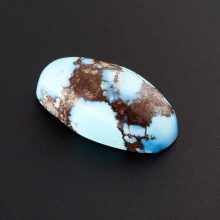
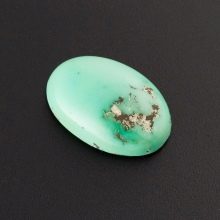
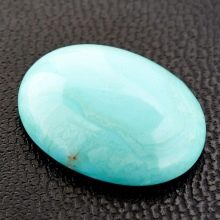
Blue minerals are rare and this is why turquoise is gaining attention in the gemstone market. The most desirable color for turquoise is blue. After blue, bluish green stones are preferred. Moreover, green and yellowish-green material is less desirable. The deviation from the pleasant blue is caused by the small amount of iron replacing the aluminum in the turquoise structure. Iron gives turquoise its green tint in proportion to its quantity. The color of the stone can also be altered by the presence of small amounts of iron or zinc, which replace the copper in the turquoise texture.
Some rocks contain inclusions of host rock (known as matrix) that appear as black or brown spider webs or spots within the material.... Often, turquoise processors try to produce stones that exclude the matrix. But sometimes it is so evenly distributed over the stone that it cannot be removed. Some people who buy turquoise jewelry like to see the matrix inside the stone.
But, as a rule, turquoise with a matrix is less in demand.
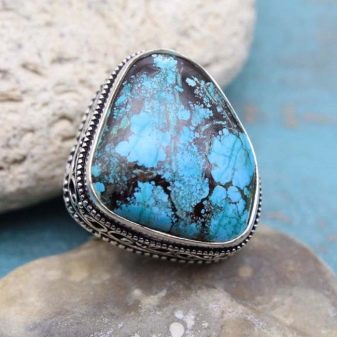
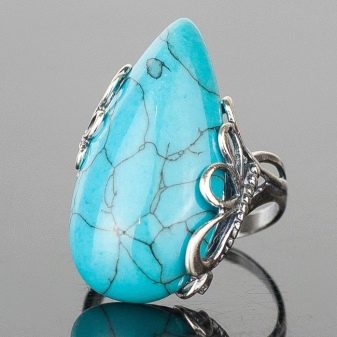
Properties
Consider the basic physical properties turquoise.
- Colors... Sky blue (most desirable as a gem), blue, bluish green, green, yellowish green; often with brown or black matrix, cobweb, or background color. Opaque stone.
- Vein - from bluish-white to greenish-white.
- Mohs hardness - from 5 to 6 (often lower due to porosity).
- Specific gravity - from 2.6 to 2.9 (variable due to porosity and matrix).
- Chemical composition - CuAl 6 (PO 4) 4 (OH) 8 4H 2 O.
- Crystal system - triclinic.
Turquoise stones have very similar chemical compositions. In these minerals, iron often replaces aluminum, and copper often replaces zinc or iron. Because they are very similar and differ in composition, these minerals are often misidentified. As a result, some materials marketed as turquoise are actually another member of the turquoise mineral group.
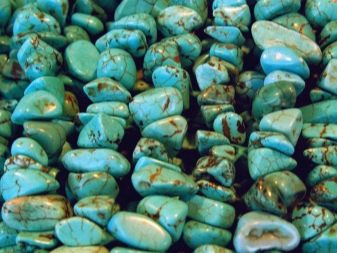
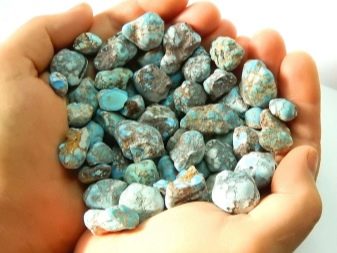
Turquoise is used mainly as a gemstone, small sculptures and decorative mineral.
Turquoise is an amulet whose magical power has been prized for centuries. Today, the mineral is known as a stone of protection, a pearl of children and women.... It adds strength, gives courage, ensures good luck and happiness in the family. It was once appreciated by racers, and today by travelers and drivers, because it protects against accidents and speeds up reflex reactions. It is also a powerful weapon against all types of calamity - the stone provides prosperity and happiness. It is given to a loved one as an expression of a pure and unchanging feeling.
It also has medicinal properties. Promotes health, improves mood and relieves depression. It is used to treat pain of various origins - from rheumatism to migraine. Strengthens the process of tissue regeneration. The stone also has a strong local effect: it can be applied to damaged areas of the body, and it is advisable to drink the water in which the stone was located. It adds energy, helps in treating viral infections and resolving stomach problems.


Turquoise is believed to have impressive metaphysical properties.
This stone has a unique vibration that resonates with the energy of truth. Exposure to this unusual energy helps a person express himself directly, honestly, and wisely. If you are a shy person, turquoise stones can help you build confidence in communication, engage more in conversations, and feel like your words have value and validity. The energy of this stone will help you act calm and relaxed when speaking in public.
You can place your stone on the third eye area while meditating. This stimulates the birth of visions known as clairvoyance. The energy of turquoise stones will allow you to start developing your intuition at a higher level. Turquoise can allow access to knowledge from a past life.

Blue turquoise
The stone brings a sense of deep calmness and can help heal emotional problems and stress, as well as prevent mood swings. This stone allows you to deeper understand the meaning of life. In the end, it will allow you to find out what is your purpose of being here at the present time. It is a powerful stone for spiritual attunement. Using it in meditation is very helpful.
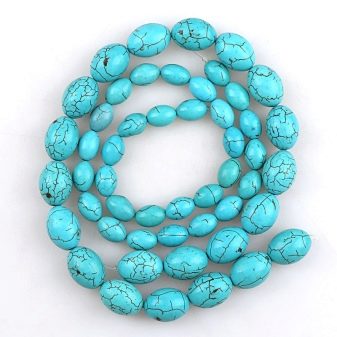
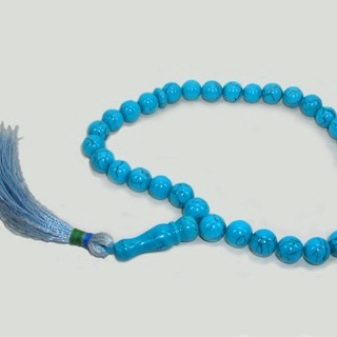
Green turquoise
The vibration of this stone is strongly manifested in the heart chakra. She directs the energy of love in all your affairs. You can relax knowing that you are protected from any negativity.
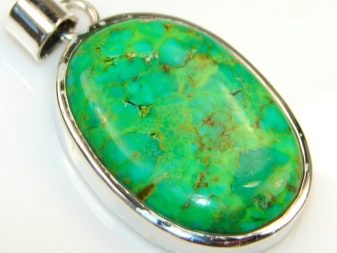

Turquoise products
Fine turquoise stone jewelry has been used for thousands of years and prized for its beauty. For centuries, they have also been used to make protective amulets. The stones were used by shamans because their vibration was known to be very powerful and had strong protective properties. In ancient times, turquoise was used to treat vision problems, including cataracts.
This stone helps you better absorb the nutrients you eat. Turquoise products are believed to help protect the body from atmospheric pollutants. Therefore, it can be useful during periods when the air is not very clean.
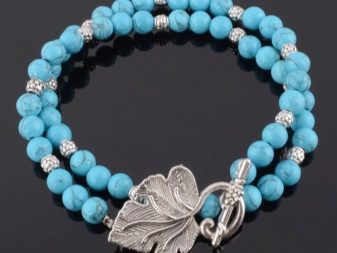

Wearing turquoise jewelry on your body will help harmonize and invigorate your body.The mineral will even allow you to develop superpowers. But the effect of the stone will be more effective if it is applied closer to the third eye.
It is a powerful stone that can be worn for protection. And turquoise necklaces or bracelets can be very effective in protecting overall health.
The mineral will enhance communication skills when worn as a necklace.
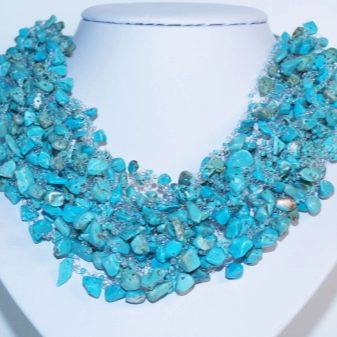
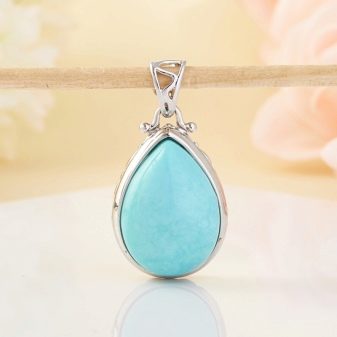
Combination with other stones
If you feel that you need to balance your masculine and feminine energies, you can combine turquoise with other crystals that harmonize it. For this purpose, you can use: sphalerite, alunite, iolite, aventurine, marcasite, golden yellow labradorite, lapis lazuli, jade, magnetite, rhodochrosite, amazonite and hematite.
Turquoise stones can be combined with other copper-based stones, including malachite, azurite, precious silica, ajoite, quinoite, or chrysocolla.
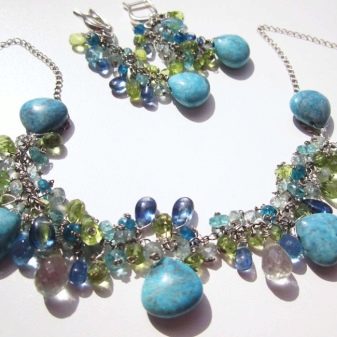
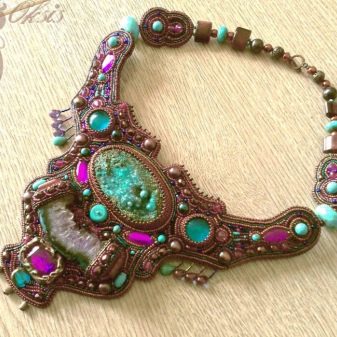
Who is it suitable for?
Turquoise is a powerful stone of spiritual attunement and is very effective in enhancing sociability. These products help you balance your masculine and feminine origins.
Turquoise is suitable for people who would like to solve many problems (or acquire additional features).
- Turquoise is a strengthening stone. It is good for exhaustion, depression, or panic attacks.
- Strengthens the physical and mental stability of the body, supports the absorption of nutrients.
- Facilitates the fight against viral infections. It is anti-inflammatory and detoxifying agent.
- Reduces excess stomach acidity.
- Turquoise helps with eye and ear diseases. With cerebral disorders. It is often recommended for the treatment of cataracts and headaches, as well as for problems with the vestibular apparatus.
- Turquoise is beneficial for the respiratory system and helps in the treatment of lung diseases and allergies. Wearing a turquoise necklace can help prevent tracheitis and asthma attacks.
- This stone can cure speech disorders such as stuttering.
- Turquoise is the most effective healerproviding health of the spirit and well-being for the body. The stone improves mood while at the same time invoking a sense of calm and equanimity. Relieves stress.
- Like a stone of purification turquoise dissipates negative energy and clears the electromagnetic smog generated by the environment.
- It promotes self-realization and assists in creative problem solving., thereby calming the nerves during public speaking.
- As turquoise soothes the mind it is good at changing time zones, reduces the fear of flying.
- Tibetan turquoise Is an excellent anti-hysteria stone that is used to calm people prone to overreacting to situations.
- Turquoise strengthens the body's meridians and subtle energy fields, improving communication between the physical and spiritual worlds. Placed on the third eye area, the stone enhances intuition.
- Promotes the development of wisdom and kindness.
- Exposure to turquoise Is a fresh, pleasant energy that brings us back to serenity when the stimulus for life is renewed. Brings hope, new discoveries and balance in life.
- Lighter stone promotes inner harmony.
- Darker, richer tones give power and flexibility. They counteract intolerance and enable us to adapt to new conditions.
- The Apaches believed that turquoise gave aid to a warrior or hunter. If turquoise was attached to a weapon or bow, the shot would hit the target directly.
- The Zuni Indians believed that turquoise can protect them from demons.
- According to Hindu and Persian legends, it was very helpful to have turquoise on hand during the new moon.
Anyone who looked at the moon on the pratipad (the first day after the new moon), and then looked at turquoise, was doomed to increase wealth and protection from evil forces.
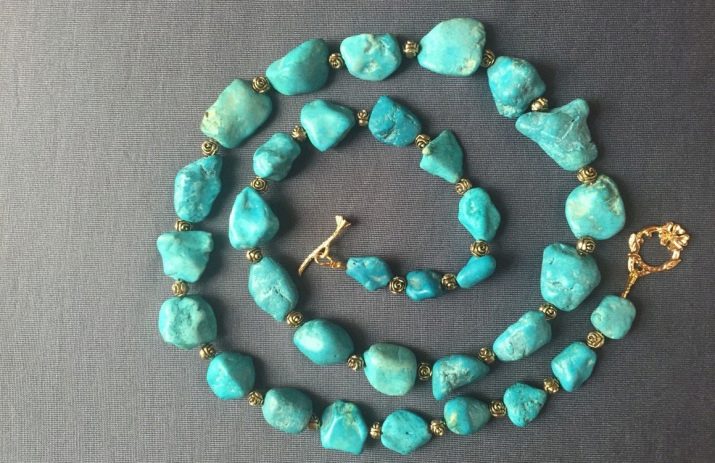





According to astrology, turquoise refers to the elements of Earth and Water. Therefore, according to the sign of the zodiac, this mineral is recommended for Pisces, Scorpions, Taurus and Sagittarius.
The stone helps to activate female sexuality. Therefore, for single women, it can be a good amulet that makes it possible to find a fan and find love. The mineral gives a man confidence and charisma, which helps to accelerate career growth.

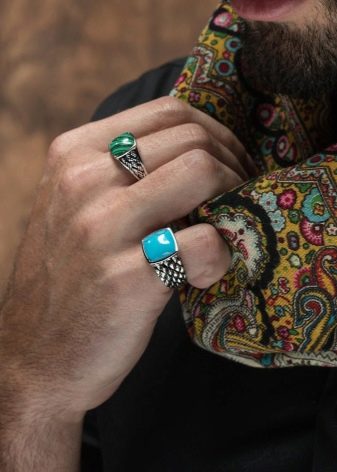
How to distinguish a natural stone from a fake?
Natural turquoise is currently one of the most expensive mineral stones. Therefore, more and more often you can find numerous imitations of turquoise, which are nothing more than a white stone, in which there is a part of natural turquoise.
To distinguish a natural mineral from a fake, it is advisable to keep in mind that there are several varieties of turquoise.
Stabilized
It is the name of a stone that has been impregnated with a resin or other bonding material to make it fairly strong for cutting and jewelry use. Stabilized turquoise can be cut into beautiful beads and cabochons. It is the most common type of jewelry in the gem and jewelry market today. This is widely known because the supply of natural turquoise is much less than the demand from people who want this stone.

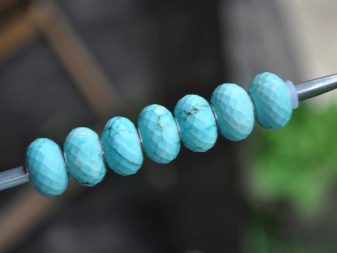
Composite or reconditioned
Made from small pieces of turquoise, which are mixed with resin and cast in the form of blocks. Finely ground turquoise can be combined with some other materials. The blocks are then sawn into small pieces that are used to cut cabochons, beads, and other items.
This material is often referred to as the "turquoise block" due to its manufacturing method.
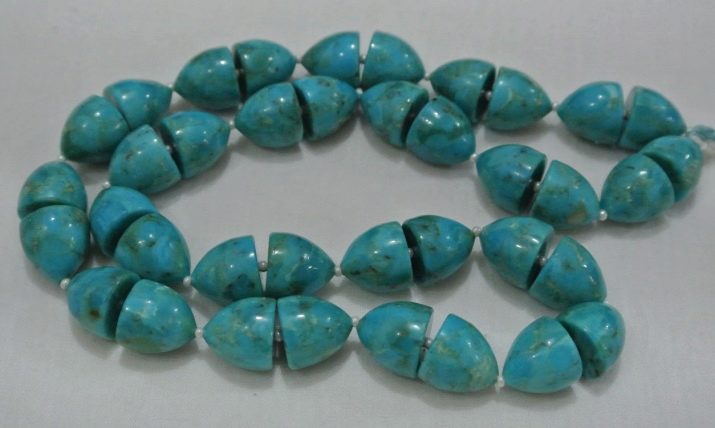
Dyed
Natural stone is a porous material and easily accepts colorants. The paint is used to transform the existing paint into a more marketable color. Composite and reconstituted turquoise are the most common types of dyed imitations. Sometimes a black or brown dye is used to change the color of the matrix material to make it more visible and uniform. Dyed turquoise always costs less than raw material of the same color and quality.
Since about the 1980s, synthetic versions of turquoise have been created, which are often very difficult to recognize, even for specialists.
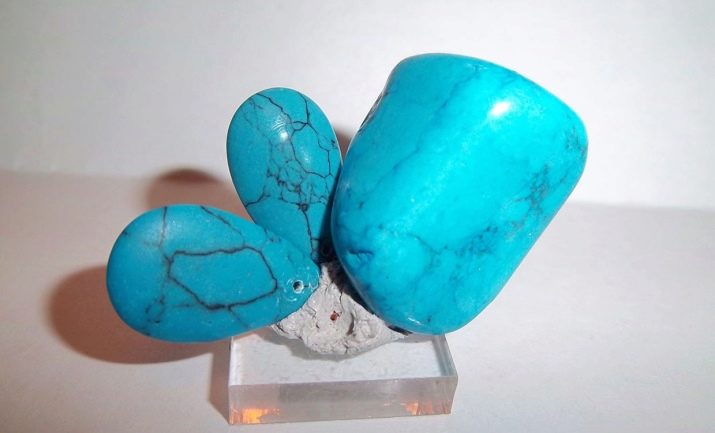
But there are cheaper (albeit natural) stones that are offered under the name turquoise.
There are several differences between natural turquoise and artificial stone.
- The weight... Turquoise is a light stone. Howlite, for example, will be much heavier.
- The size... Large stones are almost never found. The usual size for turquoise is about 50mm.
- Price... If the stone is below $ 200, it is most likely a fake.
- Scratches... If you run a needle over a natural stone, a scratch should remain. If not, the turquoise is not real. However, if the furrow still remains, but is white, this is also a fake, made of soft material. If you want to do a destructive test, keep in mind that the blue dye used to color howlite and magnesite usually does not penetrate very deeply. If you scratch the back of the cabochon with a pin, you will often see a white mark. If the part is heavily colored, it may require a deeper scratch or edge breakage to determine if the part is painted.
- Howlite and magnesite can be easily distinguished from turquoise with a refractometer. They have different refractive indices.


Care
Turquoise can be discolored due to improper care and cleaning. If you have beautifully colored turquoise jewelry, you must be careful when exposing it to impact:
- prolonged sunlight, ultraviolet radiation;
- heat;
- cosmetics, perfumes and body oils.
If cosmetics, sweat, or body oil get on the mineral, simply wipe the product gently with a soft cloth dampened in a very mild soapy solution, and then wipe with a tissue dampened in clean water. Then, after the turquoise is dry, store it in a jewelry box, away from bright light or excess heat. It is unacceptable to use any detergents containing aggressive chemical components.
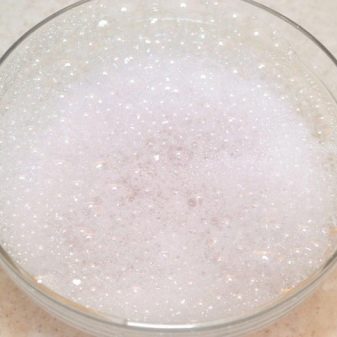
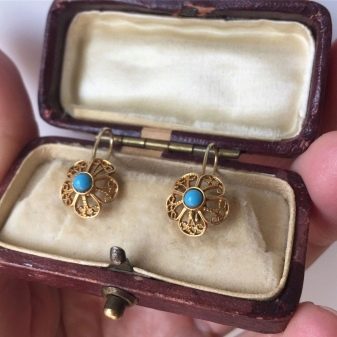
It is better to store turquoise jewelry in isolation from other jewelry items. It is believed that turquoise loses its magical properties when interacting with other jewelry.
For more information on turquoise, see the next video.








